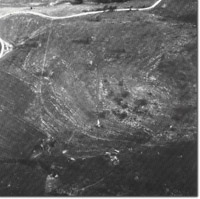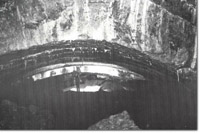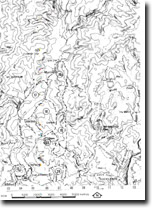8523-16 The Murrindal Area
Sites 8523 (8522) 16 to 30 - The Buchan/Murrindal Limestone Basin
This information has been developed from the publications:
|
Location: | 065584. Area around and north of Murrindal. |  Murrindal. folding and jointing in Buchan Caves Limestone. |
Abstract: | Sediments and intrusive rocks of the northern Buchan Basin; karst landforms. | |
Access: | Buchan - Gelantipy. | |
Ownership: | Predominantly private land with various Crown Reserve areas. | |
Geology: | In the Murrindal area the Buchan Group sediments are represented by Buchan Caves Limestone together with the Pyramids and McLarty Members of the Taravale Formation. Buchan Caves Limestone is exposed in cliffs on the Murrindal River and cuttings on the Buchan - Gelantipy Road. This outcrop is distinctive as it displays an algal bed up to three metres thick containing the gastropod Loxonema. Overlying the Buchan Caves Limestone are the nodular mudstones and limestones of the Pyramid Member. These beds contain the brachipod Chonetes australis. In this area the mudstone facies of the Member quickly reduces in thickness and limestone beds containing the stromatoporid Amphipora become more common. Just to the north of Murrindal the mudstone facies gives way entirely to hard dark limestones with Chonetes australis. The limestones are overlain by the McLarty Member, which is similarly composed of hard dark-grey well bedded limestones which give way to biohermal facies containing Amphipora and Stromatopoid reefs. This sequence of beds is folded into a closely spaced syncline and anticline clearly exposed on the hill to the south of Murrindal, and in the road cuttings of the Buchan-Gelantipy Road. Just north of the old Murrindal State School in the road cutting of the Buchan - Gelantipy Road, there is exposed a dark coloured volcanic sill which has intruded alone one limb of an anticline in Buchan Caves Limestone. Sills are rare in the Buchan Group and this feature is of additional interest as it clearly shows cooling features. The central section of the 20 metre wide sill is medium grained dolerite while the texture becomes progressively finer grained toward the sill edges where minor contact metamorphism of the limestone has occurred. Other basic dykes are recorded in this area, the most important being a dyke which controls the structure of Lilly Pilly Cave (M-8). | |
Geomorphology: | The major features of geomorphological significance in the Murrindal site are the caves. There are 10 well-known caves in this area, most of which occur in the Buchan Caves Limestone. The most significant cave is Anticline Cave (M-11), because of its distinctive structurally controlled form, it is rated as of International significance. This cave was formed by cavern collapse into a stream passage, followed by the partial removal of debris by stream erosion. The cave basically consists of a single chamber approximately 90 metres long, 46 metres wide and 10 metres high, with a rock-fall floor and spectacular anticlinical ceiling. In addition it contains some fine cave decoration and is used as a maternity site by the bat Rhinolophus. The bat, Myotis adversis has been recorded from this cave although it has not been recognised since 1967. Lilly Pilly Cave (M-8) was formerly operated as a private tourist cave. It is distinctive as its orientation is largely controlled by the strike of a basic dyke, and consequently its gently undulating passage cuts through limestone beds dipping at 40 degrees. This cave extends for 360 metres and has many large areas of excellent cave decoration including speleothems and the best example of rimstone barriers in the Buchan area. Murrindal Cave (M-7), which occurs nearby, is formed in the basal dolomitic beds of the Buchan Caves Limestone. It consists of well decorated chambers and is presently operated as a private tourist cave. Of the remaining caves, M-2, M-3, and M-4 are the most important. M-2 and M-3 are presumed inflow points for the permanent outflow cave M-4. Permanent outflow caves are of particular importance, being relatively uncommon in the Buchan area and in addition M-3 is well decorated with particularly good examples of flowstone. | |
Significance: | National. Anticline Cave is of International significance. In addition to the karst topography the scientific value of the area is due to the range of lithology and structure displayed in the outcrops of Buchan and Murrindal Limestones and the dykes and sills that intrude these. | |
Management: | The significance of sites displaying lithological or structural features depends upon the maintenance of a clear display of the feature. Any natural or artificial process which would obscure or remove the feature should be prevented. Insufficient information, particularly that pertinent to cave hydrology, is available to formulate a detailed management prescription for this cave area. However, the general principles outlined apply to this site. Anticline Cave (M-11) apart from its great geomorphological significance is important as it provides habitat and maternity sites for the bat R. megaphyllus. The breeding season of this bat appears to extend from November to February and it is recommended that access to this cave be prohibited during this period. | |
References: | Tiechert, C. and Talent, J.A. 1958. 'Geology of the Buchan area, East Gippsland', Mem. geol. Surv. Vict., 21: 1-56. Sweeting, M.M. 1960. 'The caves of the Buchan area, Victoria, Australia', Z. Geomorph. Suppl., 2 :81-89. Talent, J.A. 1958. 'Devonian Brachiopods and Pelecypods of the Buchan Caves Limestone, Victoria'. Proc. R. Soc. Vict., 68-70 :1-61. Matthews, P.G. (ed) 1968. Speleological Handbook. Victorian Speleological Association. Matthews, P.G. (ed) 1979. Checklist of Australian Caves and Karst. Australian Speleological federation. Nicholl, R.S. and Brush, J.B. 1976. Guidebook to the caves of South Eastern N.S.W. and Eastern Victoria. A.S.F. Guidebook No.1. | |
 Murrindal. Anticline cave (M-11). |



